I'm trying to understand what exactly this power circuit is doing. The schematic below shows 5V in from USB. It is run through a fuse, and then there's some tricky PNP transistor stuff happening I can't sort out with the DMMT5401. I don't understand the interaction it is having with the P-channel MOSFET DMG2305UX.
Since its a ptype MOSFET, then I think the DMMT is cutting off the flow of 5V using C2 under a certain circumstance. I don't know what circumstances can be derived from E1 (the 5V in) and E2 (the 5V destination) though.
Associated datasheets are shared here: https://drive.google.com/open?id=0B_rZRctloOItU2VFMkx6RHdFSmc
The 5V eventually runs out to a DC/DC converter PAM2306AYPKE which provides 1V8 and 3V3 to a device.
What I don't understand is the role of the Transistor and MOSFET in the first place. Why not just use the 5V from the fuse? Secondly, since is does exist, how does the transistor work together with the MOSFET?
(My question may derive from a hard time understanding P type devices, and the fact that this is a paired transistor, and it's modulating the performance of yet another P type device.)
